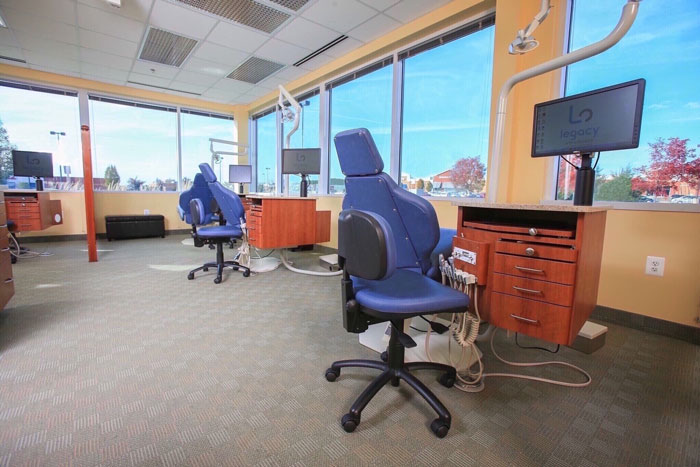Not known Factual Statements About Legacy Orthodontics
Not known Factual Statements About Legacy Orthodontics
Blog Article
The Legacy Orthodontics PDFs
Table of ContentsAll About Legacy OrthodonticsThe Single Strategy To Use For Legacy OrthodonticsWhat Does Legacy Orthodontics Do?Everything about Legacy OrthodonticsLegacy Orthodontics - Truths
In addition, we provide adjustable therapy schedules, adaptable settlement choices and a fun, satisfying experience.An orthodontist is a dental expert trained to diagnose, prevent, and deal with teeth and jaw irregularities. Orthodontists work with people of all ages, from children to grownups.
Malocclusion, or misaligned teeth, can result in dental issues, consisting of tooth degeneration, periodontal condition, and hard or uncomfortable eating. Not everyone is birthed with straight teeth. If you have a poor bite or huge rooms between your teeth, you might intend to speak with a dental professional specializing in orthodontic care.
Unknown Facts About Legacy Orthodontics
( Photo Debt: DigitalVision/Getty Images) Orthodontists use dealt with and detachable dental devices, like braces, retainers, and bands, to alter the placement of teeth in your mouth. Orthodontic treatment is for oral irregularities, consisting of: Misaligned teethBite problems, like an overbite or an underbiteCrowded teeth or teeth that are also far apartJaw misalignmentThe objective of orthodontic treatment is to boost your bite.
A healthy bite ensures you can eat, eat, and talk appropriately. While you might consider orthodontists as generally for youngsters or teenagers who need braces, they can remedy oral issues at any age. Orthodontists go to college, dental college, and orthodontic college. After college graduation, they spend 2 or 3 years in an orthodontic residency program.
, but not all dental experts are orthodontists. They focus on 2 areas: Exactly how to effectively and securely move teeth Exactly how to appropriately direct advancement in the teeth, jaw, and faceOnce an orthodontist has completed training, they have the alternative to come to be board accredited.
The Greatest Guide To Legacy Orthodontics
Imbalance, or malocclusion, is the most common reason people see an orthodontist. It is genetic and is the outcome of dimension distinctions in between the upper and reduced jaw or between the jaw and teeth. Malocclusion leads to tooth overcrowding, an askew jaw, or irregular bite patterns. Malocclusion is normally treated with: Your orthodontist attaches steel, ceramic, or plastic square bonds to your teeth.
Some people require a headgear to assist relocate teeth into line with pressure from outside the mouth. A retainer is a personalized tool that maintains your teeth in location.
They can create additional room in the mouth without having to pull teeth. Orthodontists utilize cords, surgical screws, or plates to support your jaw bone.
You may need to see an orthodontist if you have: Crowding or otherwise enough space for all of your teethOverbite, when your top teeth come your bottom teethUnderbite, when your base teeth are as well much forwardSpacing or problems with gapsCrossbite, which is when your upper teeth fit behind your base teeth when your mouth is closedOpen bite or a vertical void in between your front base and top teethMisplaced midline, when the center of your bottom and upper teeth don't line up Correcting a dental malocclusion can: Make biting, chewing, and talking easierImprove the balance of our face and your overall appearanceEase pain from temporomandibular joint disordersSeparate your teeth and make them less complicated to cleanse, aiding stop dental cavity or cavities It's commonly a dental practitioner that first notices misaligned teeth throughout a routine examination.
How Legacy Orthodontics can Save You Time, Stress, and Money.

During your first orthodontic examination, you'll likely have: An oral examPhotos taken of your face and smileDental X-raysPanoramic (360 degree) X-rays of your face and headImpressions to develop mold and mildews of your teethThese tests will help your orthodontist understand how to wage your treatment. leesburg orthodontist. An orthodontist is a dental expert that's had training to treat your teeth and jaw
Orthodontists might execute surgery, exams,X-rays,and more to aid you acquire an extra comfortable, healthier smile. An orthodontist is concentrated on your bite, so something like a broken tooth would be dealt with by a dental professional. Orthodontists are dentists but not all dentists are orthodontists. Orthodontists are concentrated on your bite, or the way your teeth meshed, and the straightness of your teeth.
Ever before wondered just how stars constantly seem to have flawlessly straightened teeth? Orthodontists are oral experts who concentrate on correcting irregularities in the teeth and jaws.
3 Simple Techniques For Legacy Orthodontics

While braces are one of the most typically recognized orthodontic therapy, orthodontists have a varied toolkit at their disposal. The details technique selected relies on read this the intensity of the instance, the client's age, and individual preferences. These tried-and-true dental braces utilize a system of braces adhered to the teeth and attached by cables.
Clear aligners, like Invisalign, are a prominent choice for clients seeking a more very discreet therapy choice. These detachable trays are tailor-made to considerably shift the teeth's placement. Headwear might be made use of in conjunction with braces or aligners to apply additional targeted pressures, especially for fixing jaw disparities. In situations of slim jaws, palatal expanders can be utilized to develop space for proper tooth alignment.
Report this page